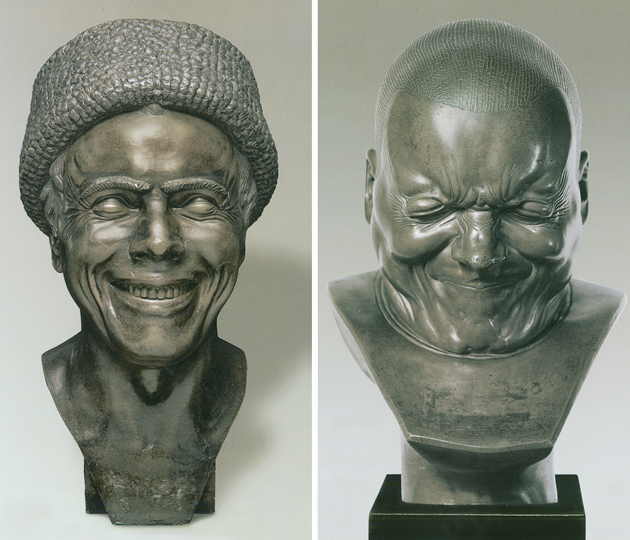Franz Xaver Messerschmidt (1736–1783) is one of those elusive eighteenth-century figures who confront us with the nocturnal side of the Enlightenment. There was always something unsettled about his biography, the life of an outsider. He was born in the small town of Wiesensteig in Württemberg, the son of a tanner. At the time, Wiesensteig belonged to the territories ruled by the Elector of Bavaria, and Johann Baptist Straub, a leading sculptor of the Bavarian rococo, was Messerschmidt’s maternal uncle. He became Straub’s apprentice in Munich and then moved on to Vienna; in 1755, as a nineteen-year-old, he shows up in a list of pupils at the Viennese Academy of Fine Arts.
Later, he was drawn into the circle of Viennese court artists. When he was twenty-four, he completed portrait busts of the Emperor Francis I and the Empress Maria Theresa at the behest of the Prince von Liechtenstein, works of orotund baroque bombast. Around 1765, the court commissioned him to sculpt a statue of Maria Theresa as the queen of Hungary. The result is a piece of courtly masquerade, lively but not graceful. If he had continued to produce such works, Messerschmidt would have earned a place in the history of late-baroque courtly sculpture: an impressive talent, but no genius.
Around 1770, however, the baroque works cease and the courtly allure disappears. The wigs fall, as do the flattering costumes. It was the hour of the Zurich physiognomist Johann Kaspar Lavater (1741–1801), and there was an awakening interest in physiognomy as a key to character. Another contemporary was Franz Anton Mesmer (1734–1815), the investigator of hypnotism and “animal magnetism” who may have been a friend of Messerschmidt’s. From then on, his busts show only the face of the natural, free man whose character, no longer decked out in breastplates and medals, speaks from his physiognomy alone.
A bust of 1770–1772 for the tomb of Gerard van Swieten, Maria Theresa’s personal physician, shows an intelligent face sinking in rolls of fat, not at all aristocratic, but lively and wide awake. Nothing is left out: the flat nose, the double chin. This transition to natural, nonaristocratic portrait sculpture can be seen elsewhere around 1770, in Joseph Nollekens’s famous head of Laurence Sterne in London, for instance—misproportioned, but fiercely intelligent—and in Jean-Antoine Houdon’s portrait of Christoph Willibald Gluck, his pockmarked face ablaze with genius. But nowhere does the blunt truth of an ordinary face emerge so honestly as in Messerschmidt’s bust of the royal physician.
An even more striking example of Messerschmidt’s radical change of direction after 1770 is the bust of the Prince von Liechtenstein, rediscovered only in 2004. This portrait, too, is unadorned: no wig, no drapery, no modish panegyric. The prince’s nobility is expressed by nothing but the acuity of a physiognomy filled with eager anticipation, simultaneously lordly in its emotion and frosty in its immobility. One senses already that Messerschmidt has still madder games yet to play with his heads.
From 1770 on, there are reports of the stubborn man’s confusion of mind. This led to a crisis in 1774, when the artist was refused the recently vacant chair for sculpture at the Viennese academy. State Chancellor Prince von Kaunitz wrote the Empress that this position could not be entrusted to a man who evinced “some confusion in his head” and “a not completely healthy imagination.” He was accused of abnormality without a clear distinction between the clinical and the aesthetic aspects of the accusation. The offended artist, clearly suffering from a persecution complex, decided to abandon the Viennese court and academy entirely and retire in self-imposed exile.
In the eyes of his contemporaries, Messerschmidt was not only a madman but also a mad artist. At the same time that he began to withdraw from society, he started to work on the project that would isolate him artistically as well, the Kopfstücke, or “character heads,” in which he concentrated his efforts to depict the passions and emotions of humanity—without a commission, without a patron, in artistic solitude. He had sculpted at least sixty of these heads—the first while still in Vienna, more in Wiesensteig, and the last in Pressburg (today’s Bratislava)—by the time he died in 1783 at the age of only forty-seven. The moment the artist turned away from courtly society, the wig gives way to the grimace.
Messerschmidt’s head-pieces are approximately life-size. Made of pewter, lead, or stone, they were perhaps first modeled in wax. The exaggerated busts have predominately round or conical heads that strain forward toward the viewer in preparation for the theatrical effect that erupts in the grimacing faces. Their contorted expressions, however, do not seem the echo of some psychic excitation, for they are inscribed on the faces with remarkably abstract lines. These seem to be the heads of clownish pranksters.
Advertisement
Messerschmidt is reported to have tried out these faces in front of a mirror. Whether he did or not, they are reminiscent of the nineteenth-century grimaciers who performed at sideshows and fairs in Paris and elsewhere. In the Wurstlprater, the popular amusement park of nineteenth-century Vienna, Messerschmidt’s character heads were exhibited as caricatures and painted pantomimes. These distorted faces are disturbing because we cannot place them in any familiar social context or assign them to any known psychic condition. The Austrian painter Arnulf Rainer, who appropriated Messerschmidt’s head-pieces in his own works, called them “lunatic images,” and the Viennese sculptor Alfred Hrdlicka spoke of “obscenities” from a “world champion at making faces.” The trivial titles assigned to individual head-pieces by an anonymous writer ten years after Messerschmidt’s death—Beak Head, The Furious and Vengeful Gypsy, The Incompetent Bassoonist—are nothing but an attempt to resist their social illegibility.
The Neue Galerie’s exhibition of no fewer than twenty-one Messerschmidt character heads displays the full spectrum of his studies of expression. The theater opens with an uproariously laughing self-portrait, as if the artist, like some latter-day Democritus, were making fun of the masquerade of grimaces he himself invented. But in the very next countenance (Quiet Peaceful Sleep), the mood turns serious and even solemn; baroque hilarity gives way to dignity and an early frost of impending classicism. This expectation is heightened even further by the next bust, The Noble-Minded Man.
But then the grimaces begin again. Facial muscles contract, eyes squint, eyebrows rise, mouths contort. The normal social conventions governing facial expression are overridden by face-making that is comic and crazy in equal measure. It is striking that Messerschmidt’s character heads are exclusively male and that the more tender feelings—love, friendship, piety—are completely absent. More than half of the twenty-one busts in the Neue Galerie are bald. Their necks, unencumbered by collars or scarves, reveal their larynxes and tendons. In this naked state, the contortions of their features are pitilessly on display. The Yawner tears open his mouth as if about to scream, his entire face transformed into a bestial mask. The gaze of the Arch-Rascal (only in the catalog) sinks to his chest as if in abject guilt. The agitated features have something self-destructive about them.
The next time we encounter such eruptions is in the anarchic art of the late twentieth century—in Bruce Nauman or Francis Bacon. Even the heads with a few remaining strands of unkempt hair or even proper coiffures display a crumpled gloom, the collapse of all expressive norms and civilized proprieties. In his last years of exile in Pressburg, the artist continued to produce the character heads that dwell, so to speak, in intellectual proximity to the other eccentrics and madmen of the waning eighteenth century: Mesmer and “Rameau’s nephew,” William Thomas Beckford and Goethe’s Werther.
The rediscovery of Messerschmidt’s head-pieces in the twentieth century occurred just as psychiatrists and art historians were becoming interested in the art of the mentally ill. The excesses of his works were read as the symptoms of his illness. Ernst Kris’s well-known 1932 essay “The Character Heads of Franz Xaver Messerschmidt” was a notable effort to use psychoanalytic criteria to understand the abnormalities in the oeuvre of a psychotic artist. This attempt has been unsettling art historians ever since. In the catalog for the Neue Galerie’s exhibition there is a thought- provoking essay by the Parisian psychologist Marie-Claude Lambotte, who diagnoses Messerschmidt’s character heads with reference to Lacan’s metapsychological theories as the reflections of a narcissistic pathology.
At this point, the art historian must raise an objection on principle. The solution cannot be simply to interpret Messerschmidt’s supposed “case history,” the undeniably pathological “confusion in his head,” psychiatrically, but also to try to understand it historically. The character heads were one of many attempts, beginning with Descartes’s treatise Les Passions de l’âme, to codify the human passions. This project kept aestheticians, physicians, and psychologists busy well into the nineteenth century.
Messerschmidt seems to have been searching for such a system but failed to find it. His character heads are decoupled from communication, autistically imprisoned, and that is what makes them so fascinating. His expression of the passions and emotions is no longer legible. Historically, they stand between the Cartesian treatise and the new iconography of mental illness that emerged around 1800 from the Salpêtrière Hospital in Paris. The silly argument about whether and “how” Messerschmidt was mad should give way to the insight that in modern society, abnormality and insanity have become part of the history of art.
Advertisement
This Issue
October 28, 2010




